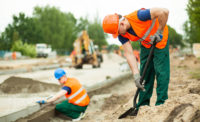How can we protect disaster cleanup teams from safety risks?

AlenaPaulus / E+ / Getty Images
Natural and artificial disasters aren’t always preventable. In fact, they’re likely to become even more frequent in years to come. Still, once the primary danger passes, cleanup teams step in to help clean up the mess and provide a blank slate for survivors to rebuild.
Even though the wildfire is extinguished or the storm has passed, that doesn’t mean the danger is over. How can we protect disaster cleanup teams from these safety risks?
Wildfire cleanup risks
Sometimes it feels like the entire world is burning. Largely attributed to the effects of climate change, extreme temperatures, droughts and wildfires are becoming more common every year. Wildfires were burning on five continents in July 2022, and the Australian bushfire season is nearly a month longer this year than in the 1970s. The brave first responders who work to mitigate these fires do excellent, selfless work to protect others and the local environment.
Once first responders extinguish the flames or they burn themselves out, cleanup can be just as dangerous. Risks when cleaning up after a wildfire can include:
- The fire itself: Even if a wildfire is considered contained, hidden embers or dry conditions can cause it to flare back up, creating more risk.
- Respiratory hazards: Exposure to smoke, soot and ash can create additional health hazards. There is also the risk of a buildup of toxic gases produced when plastic or electronics burn.
- Carbon monoxide poisoning: In addition to the air pollution created by the fire, cleanup requires using generators and other diesel-powered equipment that releases carbon monoxide.
- Heavy equipment use: Heavy equipment such as backhoes and excavators are often necessary for wildfire recovery. Only trained and experienced individuals should use these devices.
- Working in confined spaces: Confined spaces may be unstable because of fire damage, creating air quality risks if good ventilation isn’t possible.
- Downed power lines: Always assume that downed power lines are still charged unless the power company confirms. They can create an electrocution hazard.
- Exposure to hazardous materials: There’s no telling what a wildfire might encounter. Containers holding hazardous materials might be damaged and begin leaking.
This list isn’t exhaustive, but it does help paint a picture of the risks that disaster cleanup teams face after a wildfire.
Flood and storm cleanup risks
Fire isn’t the only disaster that can leave cleanup teams at risk. Severe storms are also becoming more common due to climate change. Warmer weather and increased ocean temperatures make it easier for massive and powerful hurricanes to form. Devastating derechos are also becoming more common. These weather systems are often likened to inland hurricanes and can cause unparalleled damage.
Many of the risks associated with flood and storm cleanups are similar to those for wildfires and other natural disasters, such as downed power lines, unstable damaged structures and carbon monoxide exposure. Still, there are some unique risks you might only encounter in the wake of a flood or dangerous storm. These include:
- Floodwaters at various depths: Swiftly moving floodwaters that haven’t receded can quickly sweep away rescue workers or their cars. About 2 feet of water might not seem like much, but it’s enough to swiftly move a vehicle.
- Debris: Floodwaters carry debris, which can injure rescue workers walking through them.
- Contaminants: Any wounds should be thoroughly cleaned and sealed with waterproof bandages. Floodwaters are often contaminated with sewage and other pollutants that can cause severe infections and disease.
- Mold exposure: Damp environments encourage mold and mildew growth, and exposure can create a respiratory health hazard.
Keeping disaster cleanup teams safe
What steps can we take to keep disaster teams safe as they help clean up the mess after a natural disaster strikes?
First, ensure that everyone — even volunteers — is trained on all necessary safety precautions and procedures. You don’t need to put volunteers through rigorous safety training, but they need to have at least a basic understanding of how to stay safe. You might be hard-pressed for help, but don’t hesitate to send someone home if they’re consistently putting themselves or others at risk.
Next, provide all the necessary PPE or require that everyone brings their own. Heavy gloves, masks or respirators, appropriate clothing and other tools can make the job easier without putting people at risk. Also, encourage everyone to thoroughly wash their hands before eating or drinking anything, even if they’re wearing gloves and other protective gear.
Keep a close eye on everyone as they work. Encourage people to take frequent breaks, and provide water and snacks to keep your teams hydrated and energized. Disaster recovery is hard work, and there’s often an unspoken pressure to get it done as quickly as possible so survivors can make insurance claims and start rebuilding.
Protecting disaster cleanup crews is critical
Natural disasters may become more common in the coming years, increasing our need for brave individuals willing to do the hard work of recovery after the immediate danger passes. Whether you’re a volunteer, team organizer or professional disaster recovery expert, we all need to do everything we can to keep these individuals safe as they clean up Mother Nature’s mess.
Looking for a reprint of this article?
From high-res PDFs to custom plaques, order your copy today!









